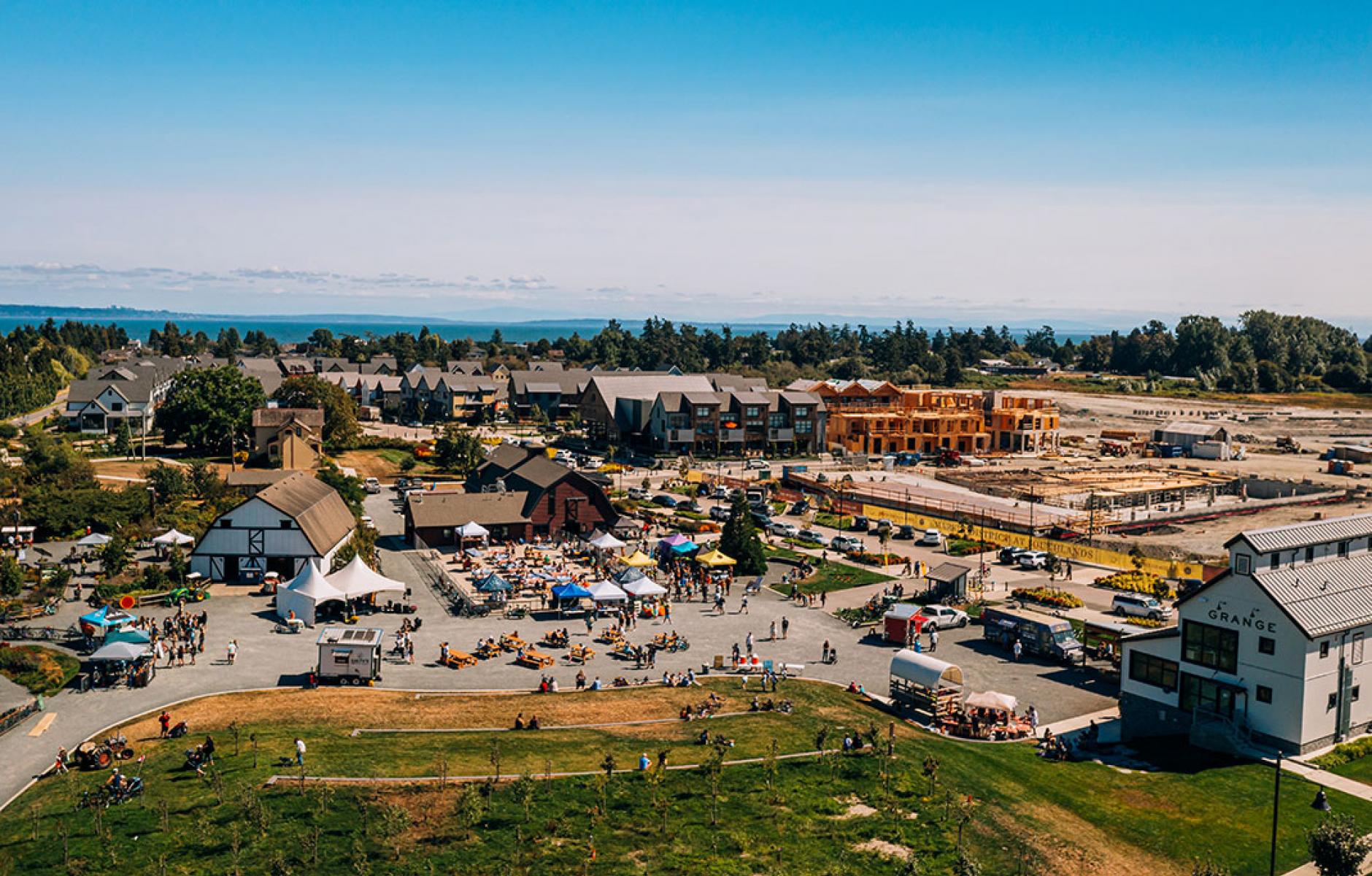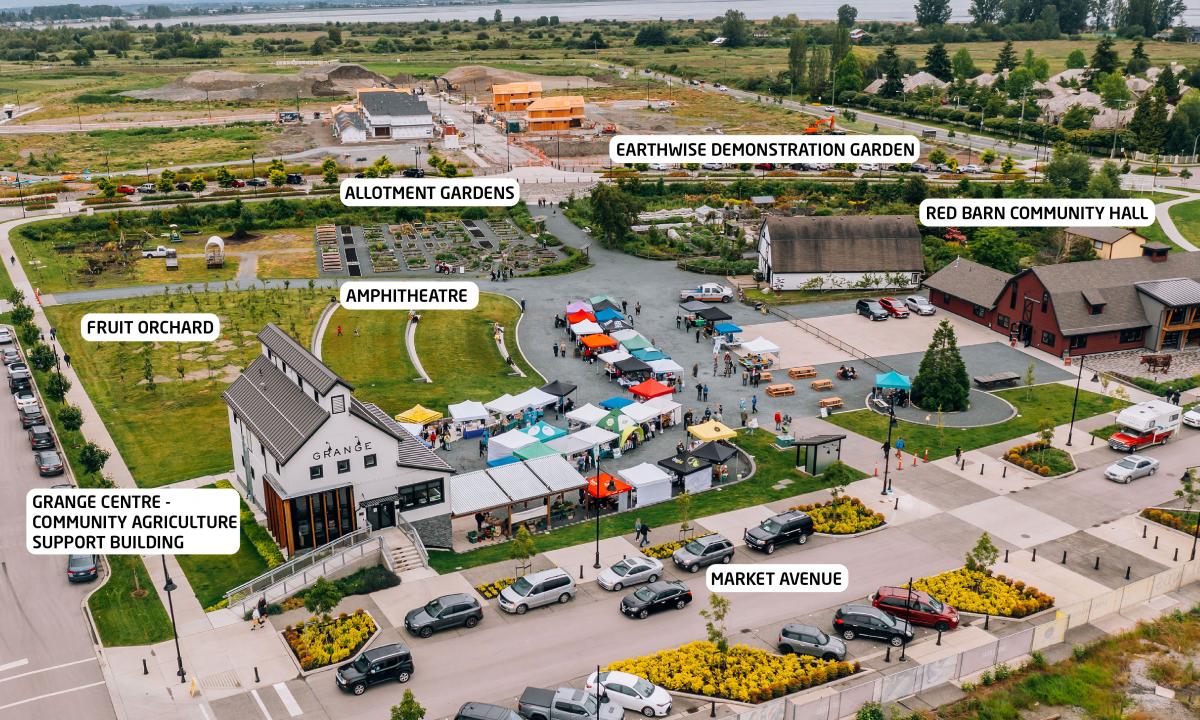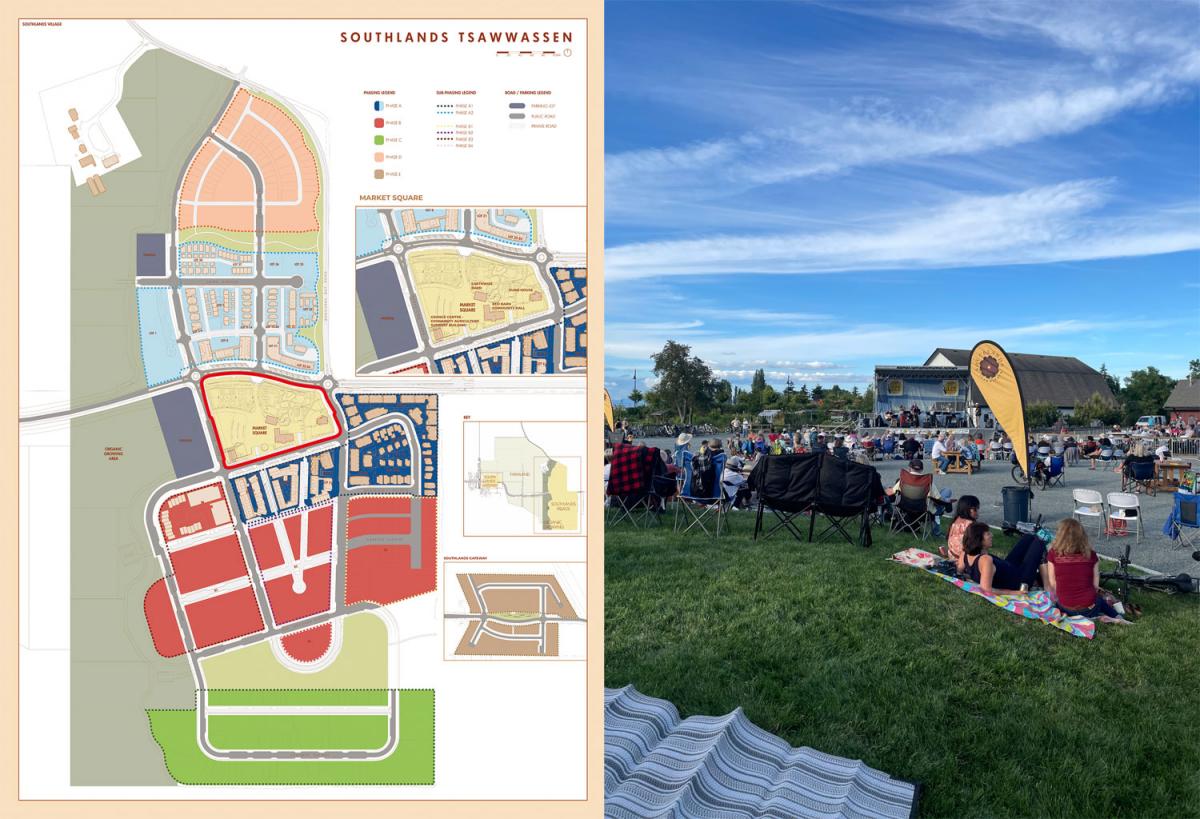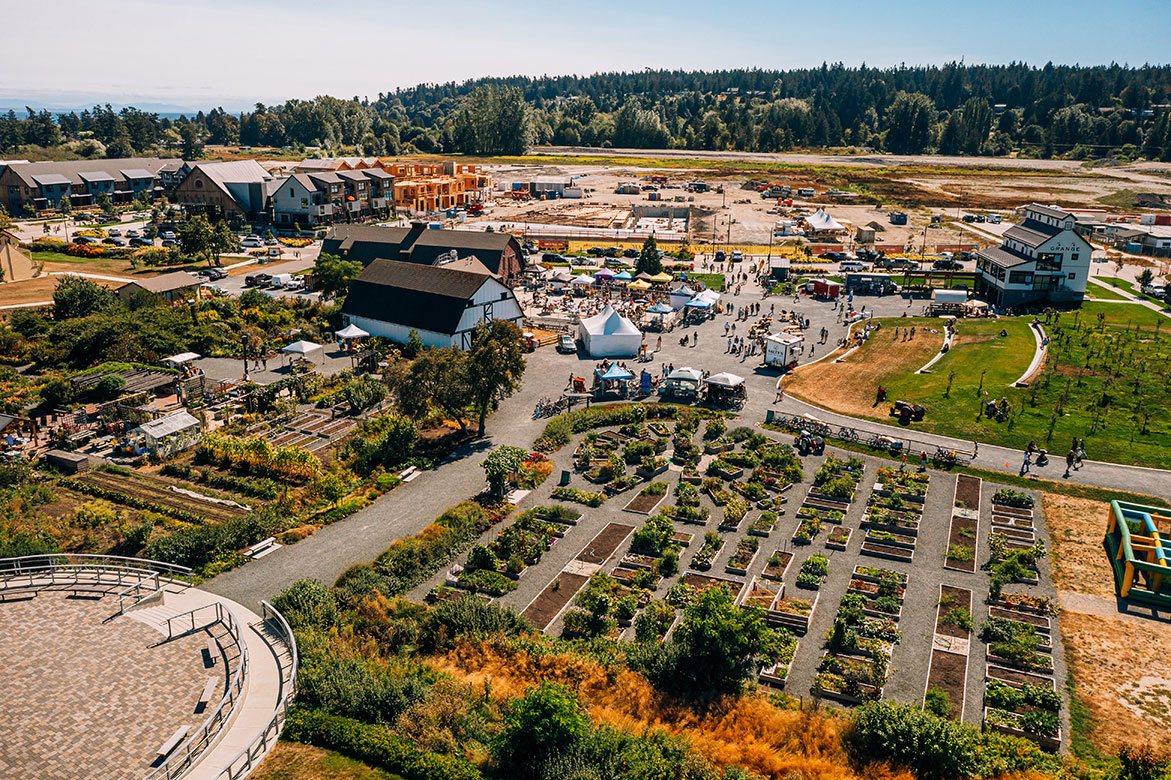
Building community from farming, food, and walkable urbanism
Agricultural Urbanism (a.k.a. Agrarian Urbanism) grew from a compromise—a grand idea that broke a political impasse. It was first proposed in a new urban plan in 2008 during the Great Recession. An innovative vision put forth at a fragile financial time, when so many projects went by the wayside, would seem to have low odds of being built. Yet since then, Agricultural Urbanism has been influential in other projects, and the original development of Southlands in Tsawwassen, British Columbia, is being built in a way that closely resembles the original vision.
Southlands Tsawwassen is a 110-acre walkable, mixed-use community built among 425 acres of preserved, active farmland. The new community is rooted in farming and food—an “agrihood” developed by applying the principles of Agricultural Urbanism.
The Market Square encompasses 5.6 acres and is the civic heart of this new farm-based community. The fully built square includes a Grange Centre community agriculture support building, a Red Barn community hall with event space and kitchen, an agricultural training barn, and a refurbished heritage house. It was designed as a public gathering place where the “people wearing dirty shoes and the people wearing clean shoes can meet”—where the farmers can interact with the larger community, according to the project team.

Adjacent to the Market Square, a neighborhood takes shape with 75 completed dwellings, small tenanted retail shops, and 100 more houses and 2,500 square feet of shops under construction. Living spaces include townhouses, duplexes, single-family detached houses, and condominiums.
In addition to the 175 homes built or underway, 775 more are entitled for a range of housing types, including missing middle (e.g., cottage courts, townhouses stacked over flats).
Located 22 miles south of Vancouver, Southlands Market Square is slightly less than a half-mile from a public beach on Boundary Bay. The Southlands community, the wider community, and visitors can meet there for events, celebrations, commerce, and activities with local agriculture to revitalize the growing culture with a new sense of place.
Market Square is built around restored farming structures, including the two barns, and the original 19th Century farmhouse. The Grange Building is a new, 3,650 square-foot structure that serves as the “hub” for local agricultural activities and includes produce washing, aggregation, and storage facilities on the ground floor and offices and meeting space on the upper floor.

An outdoor amphitheater was built for music and other performances. Approximately $7.1 million was spent by the developer in restoring buildings and building the Market Square District. The Century Group, the developer, is the constant and key to carrying the vision and implementation forward.
The roots of this project go back to 2006 when efforts to develop the land had been stymied for decades by local opposition. As reported in New Urban News in 2008, “Sean Hodgins, president of Century Group Lands Corp., which owns the vast majority of Southlands, set out to break the impasse by offering to preserve two-thirds of the site for agriculture, recreation, and educational uses while placing housing on the remaining one-third. He gathered two dozen residents to assemble a Southlands Community Planning Team, which then spent 16 months devising ideas for weaving agriculture through much of the development.”
Once the Planning Team had hammered out a design brief (titled “A Vision for Agricultural Urbanism”), Andres Duany and DPZ were brought in to lead a charrette, which included a large group of new urbanist designers and planners.
Hodgins is still president of the firm, and he and other team members have further developed the idea of a community where people see how and where food is grown, integrated into the community and home, and brought to the table. All is in service of building community. “We were hoping to bring back a place where people could really reconnect,” he explains.

The community retains 425 acres in productive farmland. “Included on that community-owned farmland is a 50-acre organic farm on land leased back from the City by the developer of Southlands and operated by a nonprofit entity dedicated to human-scale, local agriculture.” The community farm is one of the largest publicly owned farms in North America, Southlands reports.
The farm grows diverse produce sold through a CSA (community-supported agriculture) and at weekly farmers’ and artisans' markets at the Market Square. The city leases the rest of the farmland for conventional farming. “The smallest scale of farming activity extends into the Market Square district, with an area in which small-scale allotment gardens are available to the public,” notes the development team.
The remaining original land is being developed in a compact, walkable community. The “sense of place is defined by the Market Square’s strategic location at the interface between the active farmland and Southlands’ mixed-use core and strengthened by the human scale of the Square and the … new and restored/repurposed buildings,” the team reports.
“Moreover, the public engagement that is enabled by the multi-purpose design of the Market Square creates a strong sense of community by making it easy and enjoyable for the community’s residents and visitors to experience agriculture and local food in all of its forms and to gather together for weekly trade and commerce, periodic civic celebrations, and seasonal rituals.”
Even with Southlands only 15 percent built, the sense of community is strong, one resident reports, with walkable access to the farmers market, events, and café. “When I moved here, it wasn’t just buying a home. It was buying a lifestyle. … I walk everywhere. I walk down the beach in any weather or I walk through orchards and the farmlands of Southlands,” the resident explains.
The civic square at the heart of the community is unique among new urban neighborhoods, in that it is located at the nexus between active agriculture and a mixed-use neighborhood. “The Southlands plan addresses the land-use standoff at the urban/rural edge with a design solution that integrates community physical design, social and economic activities, and the landscape itself,” Marina Khoury of DPZ noted after the charrette. Value is created by integrating agriculture and urbanism, which requires nurturing a unique culture that bonds the two.
In the last 15 years, many architects and firms have been involved. ZGF Architects is listed as a project partner.
“What’s interesting about food is that it brings people together, whether it is around growing it, processing it, eating it,” notes Tracey Mactavish, principal of MOTIV Architects. Here are a few brief videos on the project put together by the developer.
Editor's note: This article addresses CNU’s Strategic Plan goal of working to change codes and regulations blocking walkable urbanism.




